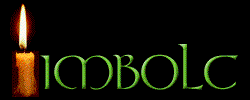Behold The Mystery | home
Imbolc

Imbolc (Candlemas) Feb.2
One of the 4 major Sabbats, Imbolc, celebrates the banishing of
Winter and welcomes the Spring. At the time of Imbolc, the newborn
Sun God is seen as a small child nursing from his Mother. Imbolc is a
time to swept away Winter and nuture new beginnings. This Sabbat also
represents spiritual growth. Imbolc is a good time to get your life
in order, whether mentally, physically, spiritually or emotionally.
The name Imbolc, is derived from Gaelic, and means "ewe's milk" after
the lactating sheep that are feeding their first born lambs of the
new season at this time of year.
Imbolc is also known as Imbolg, Oimelc, Candlemas, Feast of Brigid,
Festival of Light, Candlelaria, and Anagantious and is celebrated on
February 2nd.
Symbols used to represent Imbolc are: a representation of a
snowflake, a dish of snow, the bride, burrowing animals, grain dolly,
sun wheels, candles.
Foods in tune with Imbolc are: seeds - pumpkin, sesame, sunflower,
poppyseed breads, cakes, muffins, foods from the dairy - sour cream
dishes, meat dishes with poultry, pork or lamb, spicy dishes, all
dishes made with peppers, onions, leeks, garlic or chives, herbal
teas, spicy wines, honey, dishes containing raisins.
|
The plants & herbs associated with Imbolc are: angelica, basil, bay,
heather, myrrh, evergreens, clover, willow trees, dill, all yellow
flowers.
For Imbolc incense and oils you can use any of the following scents,
either blended together or alone: frankincense, jasmine, apricot,
sweet pear, olive, neroli, carnation, rosemary, basil, myrrh,
wisteria.
Colors associated with Imbolc are: white, yellow, pink, red, light
blue, light green, brown.
Stones associated with Imbolc are: amethyst, garent, onyx, turquoise.
Animals and mythical beasts associated with Imbolc are: robins,
sheep, lambs, deers, groundhogs, dragons, firebirds, berometz.
Appropriate Imbolc Goddesses are: all Virgin Goddesses, Flame
Goddesses. Some Imbolc Goddesses are: Athena (Greek), Brynhild
(Teutonic), Branwen (Manx-Welsh) , Vesta (Roman), Brigid/Brid
(Irish), Lucina (Roman-Norse), Triduana (Scottish), Artio (Gaulish).
Appropriate Imbolc Gods are: all Dragon-headed Gods, Flame Gods. Some
Imbolc Gods are: Bannink (Slavic), Diancecht (Irish), Essus
(Gaulish), Pax (Roman), Braggi (Norse), Dainichi (Japanese), Februus
(Roman), Trusto (Teutonic).
Altar decorations can consist of: a crown of 13 red candles, a spring
of evergreen, a besom (Witch's broom), a small statue/figurine of the
Maiden aspect of the Goddess, candle wheels, grain dollies, sun
wheels.
Traditional activities during Imbolc consist of: lighting all the
lamps in your home (either at sunset or after your ritual) - even if
only for a moment, or placing lit candles in each room on Imbolc eve,
gathering stones, searching for signs of spring and learning about
alternative healing techinques.
Taboos during Imbolc are: cutting or picking plants
Spellwork can be for: fertility, protection, as well as ones to help
define and focus on spiritual and physical desires for the future.
|
Fertility spell
If you're hoping to conceive during the spring Sabbats, start
preparing yourself with fertility magick at Imbolc (Feb. 2) by making a talisman.
Grind the following ingredients with mortar and pestle as you
visualize your (or your partner's) pregnancy:
4 parts seeds of any kind
1 part wheat
half part rice
2 parts bistort
handful of nuts
Tie the powder up in a small bag and carry it with you until you
conceive.
Afterwards, scatter the contents over the face of Mother Earth as you
offer her your thanks.
|
Imbolc Blessing
Bless thine divine light
that greets our days
so true and bright.
Come bless the coming spring
and to our hearts,
love and light bring.
I doing so let it harm none,
I ask this for me to be done.
|
